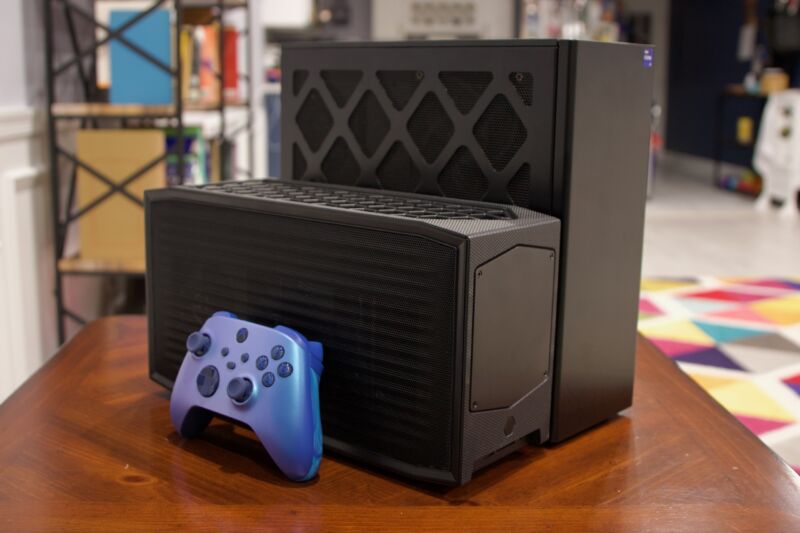Review: Intel’s “Raptor Canyon” NUC is a compact gaming PC without the stress

Intel’s NUC (Next Unit of Computing) desktops rose to prominence about a decade ago by being small; they were essentially laptops without screens or batteries, crammed inside a tiny box.
But in the years since, Intel has flirted with larger NUCs. They have always been relatively small, but as they graduated from dedicated laptop GPUs to regular dedicated GPUs to even-larger dedicated GPUs, the NUC Extreme PCs have steadily grown to the point that they’re now encroaching on do-it-yourself desktops built around mini ITX motherboards, small SFX power supplies, and other size-conscious components.
Enter “Raptor Canyon,” the latest and largest in Intel’s line of desktop PCs. It replaces the “Dragon Canyon” NUC design and improves upon it by making room for longer triple-slot GPUs—up to 12 inches (or just over 300 mm) long. That’s not enough space for one of Nvidia’s massive RTX 4090 and 4080 cards, but it can fit just about anything else.
Raptor Canyon might appeal to people who want a powerful gaming desktop without putting in the legwork, research, and trial and error that comes with building a computer inside a tiny case. It’s a desktop that won’t make sense for everyone, and there are still some trade-offs you’ll make if you buy it. But the ability to fit more powerful GPUs means it will make a little more sense than the middle-of-the-road Dragon Canyon box did.
Maximizing space
-
The NUC Extreme with the top and side panels removed. The Compute Element is on top, the GPU is on the bottom.Andrew Cunningham
-
The reverse side, with the power supply fan (upper left), the 120 mm exhaust fans (right), and drive caddy (lower left).Andrew Cunningham
The Raptor Canyon NUC Extreme box is just shy of twice the size of the old NUC Extreme—it looks like two old Dragon Canyon boxes stacked on top of each other. And Intel is using a lot of the same tricks to save space.
The heart of the NUC Extreme is the “Compute Element,” a proprietary motherboard with an LGA 1700 CPU socket, along with room for two laptop-sized DDR5 SODIMM sticks and three PCIe 4.0 M.2 slots for internal SSDs. That Compute Element plugs into the top of a separate proprietary board, which also has a PCIe 5.0 slot on the bottom for connecting the dedicated GPU (the old NUC Extreme also used a go-between board like this, but with the GPU slot next to the Compute Element slot instead of on the opposite side of the board).
Intel makes some allowances for standard parts; the unit’s 750 W power supply appears to be a standard SFX model that could be swapped out for another one, as are the 120 mm case fans that vent hot air out of the system’s left side. The side, top, and bottom panels are all mostly made of mesh for airflow’s sake. Our review unit had three 8-pin PCIe power connectors pre-installed and a 12VHPWR connector rated at 300 W. This isn’t quite enough power for an RTX 4080 or 4090, not that one would physically fit inside the case in the first place.

The Compute Element also has the majority of the computer’s ports, aside from the outputs on whatever GPU you use: one 2.5 gigabit Ethernet port, one 10 gigabit Ethernet port, two Thunderbolt 4 ports, audio jacks, an HDMI port (for integrated GPU output), plus six USB-A ports. Headers on the motherboard provide connections for a USB-C port, another pair of USB-A ports, and an audio jack on the top front of the PC for easy access.
One last upgrade over the old Dragon Canyon NUC design (for people who want even more storage than the M.2 slots can provide): An empty drive tray on the computer’s left side can fit a pair of 2.5-inch SATA drives or a single 3.5-inch SATA drive
What Raptor Canyon gains in functionality, it loses in flair. The Dragon Canyon box had some built-in LED lighting in the form of a glowing skull logo on the front (which I could take or leave) and glowing LED strips on the sides and front (which I think look nice). There are no LEDs on Raptor Canyon other than the white one around the power button, and the Compute Element doesn’t appear to include standard 3- or 4-pin RGB headers for people who want to switch the plain 120 mm fans on the side for RGB versions. I like the understated look, but people who want their PCs to light up with LEDs will be disappointed.
https://arstechnica.com/?p=1898102